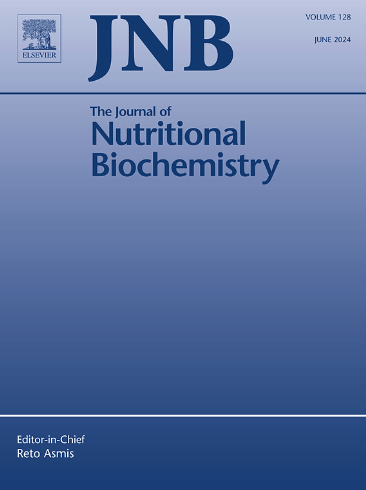Network pharmacology and transcriptomics reveal complanatoside A regulates lipid metabolism in hyperlipidemia and nonalcoholic fatty liver disease via the AMPK pathway
IF 4.8
2区 医学
Q1 BIOCHEMISTRY & MOLECULAR BIOLOGY
引用次数: 0
Abstract
Nonalcoholic fatty liver disease (NAFLD) and hyperlipidemia belong to the metabolic disorder syndromes of metabolic syndrome. They share a common pathological basis and are often complicated. Complanatoside A (CA), a flavonoid abundant in Astragali complanati semen, helps to prevent NAFLD and hyperlipidemia. However, the exact molecular mechanism is uncertain. Therefore, this study aims to explore the core mechanism. Network pharmacology was used to analyze the preventive mechanism of CA against NAFLD and hyperlipidemia. The efficacy of CA was proven in a high-fat diet-fed mouse model and a steatogenic hepatocyte model. Transcriptomic analysis, Western blot validation, and molecular docking methods were used to explore the common mechanism of CA in preventing NAFLD and hyperlipidemia. Network pharmacology revealed that the AMP-activated protein kinase (AMPK) pathway is a common mechanism leading to NAFLD and hyperlipidemia. It is also a potential pathway by which CA exerts its protective effect, which was confirmed in transcriptomics in vivo. Both in vitro and in vivo experiments showed that CA could inhibit lipid synthesis and promote fatty acid oxidation by activating the AMPK, alleviating lipid accumulation, and lipotoxic liver injury. This was demonstrated by the use of an AMPK inhibitor in vitro. Furthermore, molecular docking results showed that CA could directly interact with AMPK to regulate downstream lipid-related proteins. In conclusion, the AMPK pathway is key in developing NAFLD and hyperlipidemia. CA plays a dual preventive role in NAFLD and hyperlipidemia by activating AMPK to regulate lipid metabolism.
网络药理学和转录组学研究表明,planatoside A通过AMPK通路调节高脂血症和非酒精性脂肪肝的脂质代谢。
非酒精性脂肪性肝病(NAFLD)和高脂血症属于代谢综合征中的代谢紊乱综合征。它们有共同的病理基础,而且往往很复杂。黄芪苷A (CA)是一种富含黄芪精液的类黄酮,有助于预防NAFLD和高脂血症。然而,确切的分子机制是不确定的。因此,本研究旨在探讨其核心机制。采用网络药理学方法分析CA对NAFLD和高脂血症的预防机制。在高脂饮食小鼠模型和脂肪源性肝细胞模型中证实了CA的功效。通过转录组学分析、Western blot验证和分子对接等方法,探讨CA预防NAFLD和高脂血症的共同机制。网络药理学发现AMPK通路是导致NAFLD和高脂血症的共同机制。这也是CA发挥其保护作用的潜在途径,这在体内转录组学中得到了证实。体外和体内实验均表明,CA可通过激活AMPK抑制脂质合成,促进脂肪酸氧化,减轻脂质积累,减轻脂毒性肝损伤。通过在体外使用AMPK抑制剂证明了这一点。此外,分子对接结果表明,CA可以直接与AMPK相互作用,调节下游脂质相关蛋白。总之,AMPK通路是NAFLD和高脂血症发生的关键。CA通过激活AMPK调节脂质代谢,对NAFLD和高脂血症具有双重预防作用。
本文章由计算机程序翻译,如有差异,请以英文原文为准。
求助全文
约1分钟内获得全文
求助全文
来源期刊

Journal of Nutritional Biochemistry
医学-生化与分子生物学
CiteScore
9.50
自引率
3.60%
发文量
237
审稿时长
68 days
期刊介绍:
Devoted to advancements in nutritional sciences, The Journal of Nutritional Biochemistry presents experimental nutrition research as it relates to: biochemistry, molecular biology, toxicology, or physiology.
Rigorous reviews by an international editorial board of distinguished scientists ensure publication of the most current and key research being conducted in nutrition at the cellular, animal and human level. In addition to its monthly features of critical reviews and research articles, The Journal of Nutritional Biochemistry also periodically publishes emerging issues, experimental methods, and other types of articles.
 求助内容:
求助内容: 应助结果提醒方式:
应助结果提醒方式:


